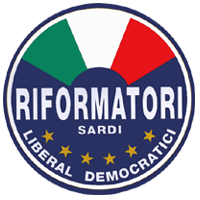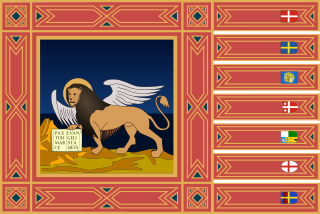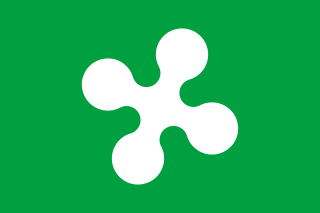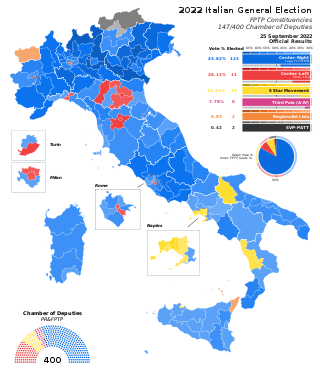
National-level elections in Italy are called periodically to form a parliament consisting of two houses: the Chamber of Deputies with 400 members; and the Senate of the Republic with 200 elected members, plus a few appointed senators for life. Italy is a parliamentary republic: the President of the Republic is elected for a seven-year term by the two houses of Parliament in joint session, together with special electors appointed by the Regional Councils.

The Greens Greens is a liberal-environmentalist political party in Italy. The party is predominantly active in Piedmont.

The Sardinian Reformers is a regionalist and liberal-conservative political party in Sardinia, led by Michele Cossa. The party, which has always been part of the centre-right at the Sardinian regional level, is a keen supporter of the free market, competition, globalization and a two-party system.

The 1994 Italian general election was held on 27 and 28 March 1994 to elect members of the Chamber of Deputies and the Senate of the Republic for the 12th legislature. Silvio Berlusconi's centre-right coalition won a large majority in the Chamber of Deputies but just missed winning a majority in the Senate.

The politics of Veneto, a region of Italy, takes place in a framework of a semi-presidential representative democracy, whereby the President is the head of government, and of a pluriform multi-party system. Executive power is exercised by the Regional Government. Legislative power is vested in both the government and the Regional Council.

This page gathers the results of elections in Veneto.
The Federalist Italian League was a short-lived federalist and liberal political party in Italy.

The politics of Apulia, Italy take place in the framework of a semi-presidential representative democracy, whereby the President of the Region is the head of government, and of a pluriform multi-party system. Legislative power is vested in the Regional Council of Apulia, while executive power is exercised by the Regional Government led by the President, who is directly elected by the people. The current Statute, which regulates the functioning of the regional institutions, has been in force since 2004.

The politics of Lombardy, a region of Italy, takes place in a framework of a semi-presidential representative democracy, whereby the President of the Region is the head of government, and of a pluriform multi-party system. Legislative power is vested in the Regional Council of Lombardy, while executive power is exercised by the Regional Government led by the President, who is directly elected by the people. The current Statute, which regulates the functioning of the regional institutions, has been in force since 2008.

Great South was a centre-right regionalist political party in Italy. The party was at times referred to as Project South.

The Sicilian Independent Labour Party was a political party in Sicily, Italy. The party was led by Ettore Lombardo Pellegrino. The party contested the Catania–Messina–Siracusa–Ragusa–Enna constituency in the 1946 Constituent Assembly election. It obtained 10,246 votes. Around half of the votes, 4,426, came from the Messina province, where the party obtained 1.50% of the votes.

The Italian Anti-Bolshevik Front was a political organization Sicily, one of several fascist groups that surged in Italy in the years following the end of the Second World War. The organization was led by Franz Navarra Viggiani. The organization contested the 1948 parliamentary election in the Palermo-Trapani-Agrigento-Caltanissetta constituency. It obtained 2,756 votes.
The centre-right coalition is a political alliance of political parties in Italy active under several forms and names since 1994, when Silvio Berlusconi entered politics and formed the Forza Italia party. It has mostly competed with the centre-left coalition. It is composed of right-leaning parties in the Italian political arena, which generally oppose immigration, and in some cases are eurosceptic.
Francesco Schittulli is an Italian surgeon and politician.

Lombardy renewed its delegation to the Italian Senate on March 27, 1994. This election was a part of national Italian general election of 1994 even if, according to the Italian Constitution, every senatorial challenge in each Region is a single and independent race.

Antonio Decaro is an Italian politician and former Mayor of Bari.

Franco Landella is an Italian politician.

Alessandro Ciriani is an Italian politician.

The 2022 Italian general election was held on 25 September, resulting in a majority of seats of both houses of the Italian Parliament for the centre-right coalition. The Meloni Cabinet was announced on 21 October and was officially sworn in on the next day. The first Cabinet headed by a female Prime Minister of Italy, it was variously described as a shift to the political right, as well as the first far-right-led Italian government since World War II. The Meloni Cabinet successufully won the confidence votes on 25–26 October with a comfortable majority in both houses of Parliament.

Massimo Cassano is an Italian politician and entrepreneur.
















